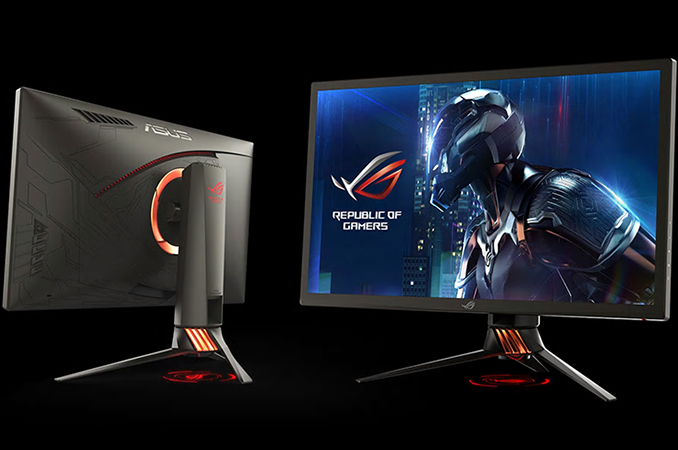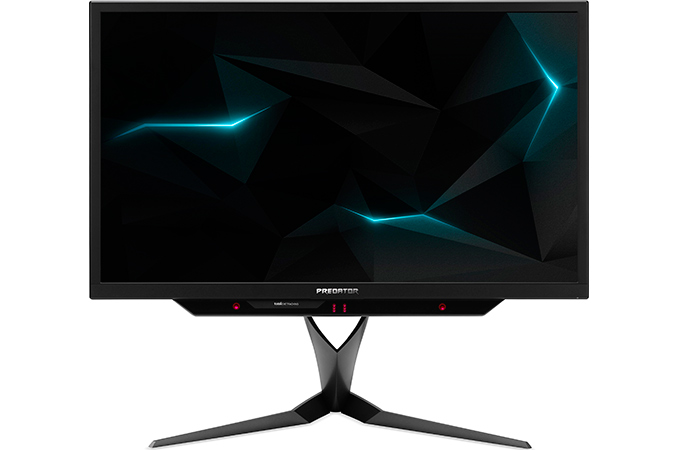NVIDIA Expects 4K 144 Hz G-Sync HDR Displays to Launch in April
by Anton Shilov on March 21, 2018 6:35 PM EST- Posted in
- Monitors
- Displays
- Acer
- Asus
- NVIDIA
- Predator X27
- ROG Swift PG27UQ
- G-Sync HDR

Acer and ASUS unveiled their prototype 27” 4K 144 Hz displays, featuring NVIDIA’s G-Sync HDR technology, at last year’s CES, with promises to release them sometime later in 2017. Both monitors relied on a reference design developed by NVIDIA and had similar specifications, albeit with some minor differences. Eventually, both companies had to delay commercial launches of their new products to 2018, missing the important holiday sales season. This week at GDC, NVIDIA has stated that it is confident that the G-Sync HDR-compatible displays will hit the market this April.
Both the Acer Predator X27 and the ASUS ROG Swift PG27UQ are implementations of NVIDIA’s reference design for G-Sync HDR displays: they offer a 3840×2160 resolution, a 144 Hz refresh rate, a 1000-nits brightness, a direct LED backlighting system with 384 zones, and feature a quantum dot film to enable HDR10 and coverage of the DCI-P3 color gamut. The monitors announced last year were to be based on AU Optronics’ M270QAN02.2 AHVA panel, which was the only one to support the combination of features that NVIDIA wanted for G-Sync HDR displays.
Neither Acer, nor ASUS, disclosed the reasons why they had to delay their ultra-premium gaming monitors from late 2017 to 2018, but given a rather unique feature-set of both displays, a lot of possibilities come to mind: starting from a panel delay by AUO to reference design changes by NVIDIA.
At GDC, NVIDIA has said that G-Sync HDR-supporting displays will finally ship in Q1, but noted that by Q1 it means its fiscal quarter, not calendar quarter. NVIDIA’s Q1 FY2019 (2019 because NV's fiscal year is one year ahead) ends on April 29, 2018, so it is logical to assume that the monitors will ship next month. What remains to be seen is the pricing as well as the final set of features and technologies.
Related Reading
- Acer and ASUS Delay Their 4K 144 Hz G-Sync HDR Displays to 2018
- ASUS Demonstrates ROG Swift PG27UQ: 4K, 144 Hz, HDR, DCI-P3 and G-Sync
- Acer Announces Predator X27 Monitor: 4K@144 Hz with DCI-P3, HDR10, & G-Sync
- Samsung Announces First Freesync 2 Monitors: CHG70 & CHG90 - Quantum Dots, Up to 49”, 144 Hz, DCI-P3
Source: NVIDIA











61 Comments
View All Comments
willis936 - Thursday, March 22, 2018 - link
Yes but that’s common knowledge. The display technology was listed in the article.TristanSDX - Thursday, March 22, 2018 - link
yesZizy - Thursday, March 22, 2018 - link
What is the point of this if we have to suffer 4:2:2?That said, when is DP 1.5 coming that will fix this issue?
edzieba - Thursday, March 22, 2018 - link
Unless it's a TV, it's 4:4:4 like any other monitor.nevcairiel - Thursday, March 22, 2018 - link
DP 1.4 has enough bandwidth for 4K, 8-bit, 120 Hz, and for 4K, 10-bit, 144Hz it can also use its DSC compression. Chroma remains untouched.risa2000 - Thursday, March 22, 2018 - link
DP 1.4 standard can do that, but is there any card that fully supports DP 1.4? As far as I noticed the latest models from NVIDIA and AMD were "DP 1.4" ready, which meant they supported slower transfer speeds with DP 1.4 signaling. I also have not seen any bridge chip (DP<->MIPI) which has full support for DP 1.4 speeds.edzieba - Thursday, March 22, 2018 - link
"which meant they supported slower transfer speeds with DP 1.4 signaling"DP 1.3 and DP 1.4 have the exact same link speed.
risa2000 - Thursday, March 22, 2018 - link
Well, then I would rephrase my question in this way: Has anyone seen a product (monitor, gfx card) which supports all the speeds to the max defined in DP 1.3 (and subsequently DP 1.4)?Ryan Smith - Thursday, March 22, 2018 - link
There has been no announcement of any changes to the underlying tech. So we'll see where things stand when it ships, but AFAIK it's still using 4:2:2. DSC is not being used.willis936 - Thursday, March 22, 2018 - link
3840*2160*30*144 = 35.8 GbpsDisplay port 1.3/1.4 max bitrate is 32.4 Gbps. In order to have all features enabled at once DSC must be used. You can kick the refresh rate down to the still very acceptable 120 Hz, bump down to 8-bit (boo), or do the unthinkable and lower the resolution to fit within DP 1.4's link budget.
If I had a monitor like this I'd be interested in ULMB. I never use G-Sync on my monitor and always use ULMB 120 Hz. I feel like this is a very underappreciated feature and it doesn't get talked about much. Regardless of price ULMB is a make or break feature for this monitor to me and there's no mention of it being present or not being present. I assume it will be since it's part of G-Sync but if they've been going on a feature slash I can see ULMB going to the chopping block.